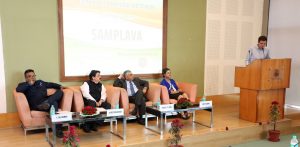
Jindal School of Journalism and Communication organized a 2-day joint forum with the University of Oregon on the theme of Media Culture and Politics from August 8-9, 2019 with the aim to situate communication technologies at the center of societies, cultures, politics and networks. The conference attracted academicians and scholars from across the world to present their research work.
Biswarup Sen, University of Oregon, School of Journalism and Communication and Tom Goldstein, Founding Dean, Jindal School of Journalism and Communication gave the welcoming remarks. Mr. Arvind Rajagopal, professor of Media Studies at New York University gave the keynote address and briefly discussed about ‘How India Became a Success Story in the Global South, and what Media Theory Has To Do With It’. He linked the present day scenario to the early post-independence period through an examination of a history of media and media theory in their global dimension.
The first panel discussion of the conference was centered around ‘Twitter, Journalism and Elections’. The popular microblogging social media platform Twitter has been prominently covered in the press for its perceived role in activism, disaster recovery, and elections amongst other things. Anmol Panda from Microsoft Research India gave his insights on how Indian political parties used Twitter in 2019 general elections in the panel discussion on. With a dataset of 15000 Indian politicians’ tweets, Professor Panda showed that tweets influence trending topics online, and that there is a bias towards regional languages. The possibility of social media being used by political figures to exacerbate violence instead of enhancing public discourse was explored in Rajeev Ravishankaran’s presentation.
The discussion in the subsequent panel shifted to “Digital Cultures, the Political, and the Social”. Fathima Nizaruddin from Jamia Millia Islamia University elaborated on the role of WhatsApp messenger within Hindutva mobilization. With over 200 million users, WhatsApp is a major platform of communication in contemporary India. However, the app is also used to form ecosystems of hate which precipitate violence. Dibyadyuti Roy from IIM Indore challenged the subaltern narrative which states that digital and new media platforms are the new empowering spaces, removed from the divisiveness of caste. He quoted from his research paper: “I draw attention to India’s “digital divide”—where over 800 million people do not have access to the Internet— and argue that such disparities cannot only be attributed to infrastructural issues but also to models of development, which perceive “digitality as purity”: only meant to accessed by individuals with a certain form of caste capital and related privileges. He further stressed on the representational politics of web series—on indigenous streaming platforms like Netflix and Amazon Prime Video – which are seen as “progressive” new media entertainment sources for Indian audiences but reflect a bias toward issues that would largely interest a specific demographic: privileged upper caste youth who represent the elitism associated with digital spaces in India.

The third and final panel of the day was on ‘Media Cultures and National Identities’ which examined the relationship between communication technologies and the making of “people” in contemporary times. Yashodhara Rakshit from Jindal School of Liberal Arts and Humanities described the changing archetype of female avenger. Their transgression from traditional gender roles into female avengers were made through films like ‘Kahaani’ (2012), ‘Mardaani’ (2014) and ‘NH-10’ (2015) where they mete out a different kind of justice. To consolidate her argument, she added “They are not submissive archetypes but instead actively push against marginalization without the aid of male counterparts.” Professor Anugyan Nag from Jamia Millia Islamia University elevated the discussion to Bollywood dance and its multifarious avatars in digital and social media platforms. He stated that choreographed dances have given Bollywood dance its identity, allure and circulation as a spectacular form that is immensely pleasurable. It is this uniquely cinematic aesthetic dance form that has taken on an independent identity impacting forms of performance and entertainment that is ubiquitous today in different spaces and media.
On the second day of conference, the dominant theme was ‘Media, Religion and Identities’, where the scholars decoded right-wing media, identified the ‘Muslim’ in contemporary media culture and unraveled nationalism that is fleeting in the form of images and videos on national television. Professor Gowhar Farooq exposed the radicalness within Sanathan Sanstha’s videos which disrupt communal harmony; whereas Professor Srirupa Bhattacharya from Miranda House starkly attacked Baba Ramdev to invoke swadeshi and nation-building as an advertising strategy for the products of Patanjali Yogpeeth and imploring followers to shun foreign brands. While talking about the implication of this trend, she said “This is completely different from the vision of Vivekananda or Gandhi, who talked of nationalism through renunciation and charity.”

In another discussion on the ‘Labour and Technology: Aesthetics and Right’ Prof. Ishita Dey from South Asian University focused on self-articulation of meanings of work among a cross section of workers involved at various stages of sweet-making in West Bengal and Bangladesh and Prof. Sumit Mhaskar from Jindal School of Government and Public Policy discussed about Mumbai’s ex millworkers’ political mobilization on rehabilitation.
Hartosh Singh Bal, political editor of The Caravan magazine gave the closing keynote address and in brief discussed the futuristic trends that the contemporary media is going to witness in the forthcoming times. Prof. Kishlay Bhattacharjee, Vice-Dean of JSJC gave the closing remarks for the conference and thanked all the academicians and scholars for being a part of the conference.
Experts in the conference concluded that over the years, journalistic and media cultures have altered with populist, nationalistic discourses and neoliberal imaginations. The inequalities, aspirations and empowerment that are surfacing in the society have played a major role in growth and expansion of communication technologies and digital infrastructures.

